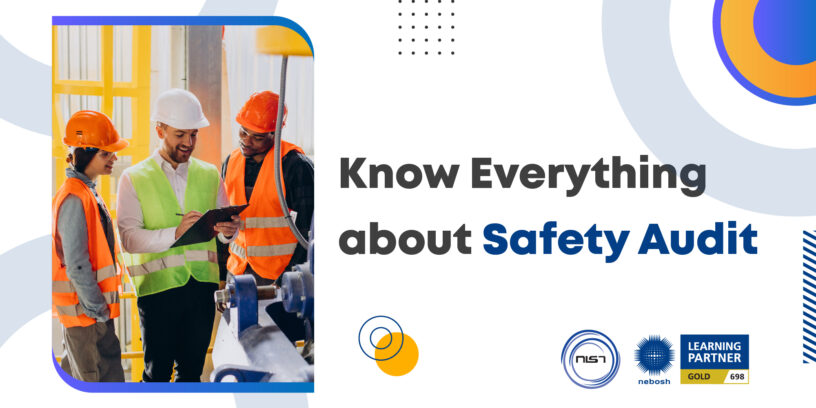All businesses should implement regular health and safety audits as best practises. A safety audit meticulously gathers data on a company’s effectiveness, productivity, dependability, and safety. To gauge these characteristics, an auditor will examine the practises, equipment, working environment, and other elements. Costly penalties might result from breaking health and safety rules and laws. Along with court fines, other issues include medical expenses, insurance pay-outs for accidents, and loss to a company’s brand. A violation is evidence that a business owner has not upheld their moral obligation to help ensure that both their employees and customers have a safe workplace. For this reason, organisations should perform regular health and safety audits.
So let’s discuss the value of a safety audit and how to conduct a successful health and safety audit for your organisation.
What is Safety Auditing?
Safety auditing, a component of safety management, entails a methodical, critical evaluation of operations. One or more system components, such as safety regulations, process enhancement, operating guidelines, and emergency protocols, may be the subject of an audit. The goal is to draw attention to the positives and negatives, pinpoint danger zones, and create corrective action. An audit may provide a report, which is then followed by an action plan developed by the audited organisation and approved by the legal and regulatory authorities, depending on the audit’s scope and objectives.
Three (3) categories of audits:
- Compliance auditing: A condition inspection falls under this category of audit. This audit examines three factors—adherence, record-keeping, and training—and focuses on risky environments.
- Program auditing: In this audit, the execution and strategy of safety programmes are assessed.
- Management system auditing: This form of audit evaluates the management’s effectiveness and dedication to safety compliance, programmes, risk control measures, and employee involvement.
Safety audits are carried out to make sure that:
- The company has a sound organisational structure and a enough number of employees.
- Following approved guidelines and procedures is done, and employees have the necessary knowledge and training to use and maintain facilities and equipment.
- The equipment is capable of operating according to the service’s safe procedures.
- There are efficient mechanisms in place for promoting safety, assessing safety performance, and resolving safety-related issues.
- Enough plans are in place to handle foreseeable emergencies.
How to set up a safety audit system?
As the audit process gets under way, work internally with any pertinent stakeholders to build a suitable plan and timeframe that addresses the project’s scope and establishes key requirements such an organization’s policies, practises, and programmes. Identify any additional tools you will need to complete the audit, such as checklists.
Specific questions about safety audits should be addressed by the checklist, such as:
- Is the most recent version of our safety manual available to all employees?
- Are the members of our management team aware of their responsibilities for health and safety?
- What are the steps we take to report hazards?
- When do we perform safety inspections?
- Is the fire risk assessment reliable?
These are merely a few fundamental inquiries. The ability to tailor a health and safety assessment to the size, goals, and concerns of your business is crucial. A health and safety audit template does not exist that is “one size fits all.” In order to ensure that the audit includes the right questions, you must carefully study your business. You can think about how to conduct the audit once you have a complete list of objectives.
Health & safety audit procedure
A safety audit can be divided into the following steps.
- Planning an audit: Here, you will choose the audit’s scope and aim as well as any applicable standards and past audit findings.
- Perform the audit: This step entails carrying out the audit in accordance with the strategy. Both real work settings and deviations from established safety protocols are logged.
- Make a report on the audit: The findings should be highlighted in the report. There ought to be both positive and negative outcomes. A summary of the audit report should include recommended actions and areas for improvement.
- Set corrective action priorities: Prioritization and a deadline should be given to the suggested actions. Some folks could require immediate assistance, while others might not.
- Release the audit results: The modifications and ideas should be explicitly stated. Everyone will benefit from having a better knowledge of the necessary changes and how they may influence them and their jobs.
Benefits of Safety Audit
- Encouraging regular system assessments to make sure they are not disturbed by poor practices.
- Facilitating planned improvements to programmes, policies, and procedures.
- Find and note areas where the human resources division can be improved.
- Displaying a strong commitment to protecting the general health and safety of employees.
- Confirming the correct application of safety programmes by management and staff.
- Examining adherence to pertinent safety regulations.
- Finding and identifying potential threats (existing and new).
- Evaluating the efficiency of the management controls in place today
- Fostering a safe workplace while lowering the likelihood of an accident or harm.
- Determining objectively whether the company’s safety performance and training are adequate.
NIST Global – Your Safety Partner for Audit
Get the best OHS audit from NIST expert auditors to ensure a safe workplace. We provide corporate clients in need the following OHS auditing services:
- Occupational Health & Safety Audit
- Pre-occupancy safety Audit
- Construction Safety audit
- Fire & Life Safety Audit
For details about NIST Global corporate auditing services, contact our client servicing team @ +91 9384663536 or mail us at corporate.sales@nistinstitute.com














Leave a Reply